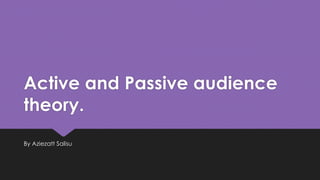Active and passive audience theory
•Download as PPTX, PDF•
0 likes•499 views
Report
Share
Report
Share

Recommended
More Related Content
What's hot
What's hot (19)
Audience Theories: From Source-dominated to Active Audience Theories

Audience Theories: From Source-dominated to Active Audience Theories
Viewers also liked (9)
Similar to Active and passive audience theory
Similar to Active and passive audience theory (20)
C:\documents and settings\paul neville\my documents\influences on the audience

C:\documents and settings\paul neville\my documents\influences on the audience
More from Aziezatt Salisu
More from Aziezatt Salisu (17)
Active and passive audience theory
- 1. Active and Passive audience theory. By Aziezatt Salisu
- 2. The Hypoermic Syringe Mode. The Passive Audience. The hypodermic syringe model was developed in the year 1930. All of the audience react in the same way, the audience are manipulated. The audience thoughts and behaviour are affected by the media. It shows that the audience will copy whatever they see on the television.
- 3. Uses And Gratifications Mode. This theory suggests that media audience make active use of the media in order to fulfil their needs. Blumler and Katz 1974 developed the uses and gratifications model to identify four needs which are escapism, information, social interaction, personal identification. These four needs were fulfilled by viewing television Escapism/Entertainment is a from of escape from everyday pressure. A source of entertainment. Information/Surveillance is information about what’s in the world. Personal identity is comparing own life with characters and situations portrayed and to explore individual problems and perspectives. Social interaction is sociability through discussion about TV with other people.
- 4. Reception Theory. This theory was develop by Stuart Hall. Stuart Hall model Is the idea that an active audience has to decode the meanings within a text, therefore different audiences will do so in different ways.